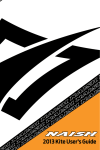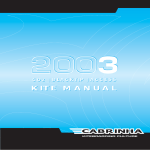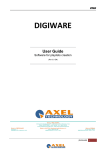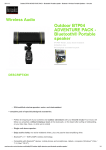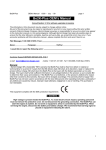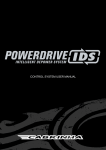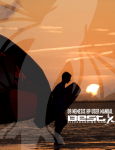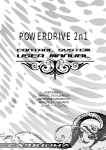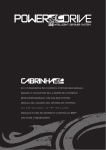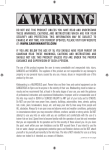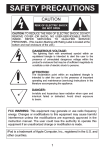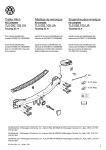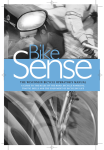Download CK`02 Manual 1.3.5(QXPv3.3)
Transcript
2002 KITE MANUAL SOLID KITEBOARDING KITEBOARDING EQUIPMENT EQUIPMENT SOLID RELEASE OF LIABILITY AND ASSUMPTION OF RISK DO NOT USE THIS PRODUCT UNLESS YOU AGREE WITH THE FOLLOWING TERMS AND CONDITIONS IMPORTANT WARNING! THIS WARNING IS FOR YOUR OWN SAFETY AND PROTECTION. IF YOU DO NOT AGREE WITH THESE TERMS AND CONDITIONS, DO NOT USE THIS PRODUCT. KINDLY RETURN THIS PRODUCT BEFORE USE, AND YOUR PURCHASE PRICE WILL BE REFUNDED IN FULL. The user of this product is an adult who understands that the use of this product may expose the user to certain unavoidable risks, dangers, and hazards. The user of this product voluntarily assumes these risks. Before using this product, the user has carefully reviewed, understood, and agrees to comply with the terms of the User's Manual. The user of this product understands and agrees to comply with the terms of the sale. YOU MUST READ THIS INCLUDED USER MANUAL BEFORE USING THIS PRODUCT. The user of this product understand that the seller is not responsible for any damage to property or injury caused by negligent operation of this product by the user, and the user releases the seller from all such liability. THE INFORMATION CONTAINED IN THIS MANUAL IS FOR YOUR REFERENCE AND MAY BE SUBJECT TO CHANGE AT ANYTIME. PLEASE VISIT OUR WEBSITE AT: Kite surfing is an adult sport. Power kites and their lines and control equipment can be dangerous to flyers and to anyone in the vicinity of their use. Kite surfing must be taken seriously and we recommend that, at least in the early stages of your use, you seek the guidance of experienced kite surfers. www.cabrinhakites.com FOR CURRENT UPDATES TO THIS MANUAL. Improper and/or negligent use of this kite may result in serious injury or death to yourself and others. Do not use your kite near power lines, airports, streets and keep your kite fly lines away from people and obstacles. Always fly in an open area, observe wind and weather conditions, particularly in circumstances where you may encounter offshore winds or strong winds. Do not attempt to use your kite on water until you are confident and comfortable with its use on land. Spend time to become familiar with the operation of your kite and remember that you are responsible for its safe operation and for the safety of those around you. As you learn the sport, work within your own limitations and do not exceed them. If you intend to use the kite on water, always use appropriate safety and floatation devices and do not attach yourself or tie yourself permanently to the kite lines. The kite is not intended for use as a flying device nor indeed is it intended as a means of flotation. CONTENTS INTRODUCTION . . . . . . . . . . . . . . . . . SAFETY . . . . . . . . . . . . . . . . . . . . . . . BLACK TIP KITE . . . . . . . . . . . . . . . . SETTING UP YOUR BLACK TIP KITE KITEBOARDING BASICS. . . . . . . . . . KITE CONTROL AND STEERING . . . . STARTING . . . . . . . . . . . . . . . . . . . . . SECURING THE KITE . . . . . . . . . . . . LAUNCHING WITH A PARTNER . . . . SELF LAUNCHING . . . . . . . . . . . . . . . LANDING . . . . . . . . . . . . . . . . . . . . . . RE-LAUNCHING . . . . . . . . . . . . . . . . . KITE-REPAIR . . . . . . . . . . . . . . . . . . . GLOSSARY . . . . . . . . . . . . . . . . . . . . BEACH ETIQUETTE . . . . . . . . . . . . . . 2002 KITEBOARDING MANUAL . . . . . . . . . . . . . . . . . . . . .PG. . . . . . . . . . . . . . . . . . . . . .PG. . . . . . . . . . . . . . . . . . . . . .PG. . . . . . . . . . . . . . . . . . . . . PG. . . . . . . . . . . . . . . . . . . . . .PG. . . . . . . . . . . . . . . . . . . . . .PG. . . . . . . . . . . . . . . . . . . . . .PG. . . . . . . . . . . . . . . . . . . . . .PG. . . . . . . . . . . . . . . . . . . . . .PG. . . . . . . . . . . . . . . . . . . . . .PG. . . . . . . . . . . . . . . . . . . . . .PG. . . . . . . . . . . . . . . . . . . . . .PG. . . . . . . . . . . . . . . . . . . . . .PG. . . . . . . . . . . . . . . . . . . . . .PG. . . . . . . . . . . . . . . . . . . . . .PG. 4 5,6 7 8-22 23-24 25 26 27 28,29 30,31 32 33 34-38 39-40 41 INTRODUCTION 2002 KITEBOARDING MANUAL We at Cabrinha would like to THANK YOU for purchasing your new Cabrinha kite and to welcome you to Cabrinha. As you may know, the excitement of kiteboarding is attracting people of all ages from all corners of the globe. It’s one of the most dynamic and fastest growing sports of the new decade. It can also be overwhelming if not approached in an educated and safe manner. That’s why we have supplied this extensive user’s manual. It will help to educate you about your new kite and about the safe ways in which to use it. It also contains information regarding the set-up, care and maintenance of your new kite so that you can spend as much time on the water as possible. Please read this user’s manual carefully and entirely before using this kite. Also, do not attempt to kiteboard without appropriate instruction. It will make this sport safer, not only for yourself, but for those around you. SAFETY KITEBOARDING is an extremely diverse sport, with many disciplines and ability levels. As with all sports, there can be certain inherent risks. The following contains key safety points to remember when operating your Cabrinha kite. • Always use this kite with the supplied wrist leash system. • NEVER permanently attach yourself to this kite, the control bar, or lines. • NEVER use this kite as a flying device. • NEVER touch the bridle lines or the kite lines while under tension; do not catch the kite using any of these lines. • When inflated but not in use, secure your kite with sand or with something heavy…the more weight the better. An inflatable power kite will still fly, even without a pilot, so be mindful of those around you and secure your kite. Your kite may cause serious injury or death if it launches unexpectedly. • Do not lend your gear to someone who has not been fully instructed on the use of inflatable kites. Other users should also read this user’s manual and be proficient in all its points. SAFETY GEAR We strongly recommend the use of the following protective gear: • GLOVES • EYE PROTECTION • SUNSCREEN • SAFETY KNIFE • HELMET • NEOPRENE WET SUIT • FOOT PROTECTION • LIFE JACKET OR FLOTATION VEST WIND, WATER & WEATHER CONDITIONS • Do not underestimate the power of the wind. • Be educated about air and water temperatures and wear appropriate protection • Avoid "offshore" wind conditions and use against the elements. extreme caution in "onshore" wind conditions. • Do not use this product in thunderstorms. • Avoid strong, gusty wind. • Be careful of wave conditions, especially when • Consult an anemometer to determine wind speeds if necessary. learning. • Be educated about tides and rip currents. CONT’ SAFETY KNOW YOUR ABILITY LEVEL CONT’ • Do not attempt kiteboarding without appropriate instruction. • Do not kite alone. • Launch, land, and ride together with a partner or have someone on shore who can keep an eye on you. • Make sure you are in good physical condition before using this product. • Practice flying a small, traction kite or a "trainer kite" before flying this kite. The more time KITEBOARDING LOCATIONS • Check your area thoroughly before launching your kite. • Observe local laws and regulations regarding this product and the usage area. • Avoid launching, landing or using this product near power lines, telephone poles, trees, people, pets, buildings, automobiles, streets, and airports. • • • • • spent on the "trainer kite" the homework and that you know safer and the better. the safety precautions of all aspects of the sport; launching, Make sure you are a proficient landing, flying, riding, kiting swimmer before using this among other water users, selfproduct near the water. rescuing, etc. Make sure the wind and water • Understand the technique of conditions are within your ability self-rescue before using this level and that you have made product near the water. the correct gear choices. Never kiteboard further from • Never let someone who is not familiar with inflatable kites shore than you are able to launch or catch your kite. You swim back. will endanger them, as well as Always save a reserve of eneryourself and those around you. gy. End your kiteboarding sesYou are responsible for the safe sion before you are exhausted. operation of your kite. Make sure you’ve done your • Avoid crowded beaches and waterways. • Make sure you have considerable space in which to launch, land, and use this product. • You should have at least 100 meters of space on both sides and downwind of you. Be especially alert of your downwind area. • Avoid areas with rocks and/or reef. • Be careful and mindful of other water users, including wind- • • • • surfers, boaters, jetskiers, swimmers, etc. Be mindful and aware of the wind direction in relation to your launch area. Before launching, make sure you have scouted a safe landing area, in case you do not make it back to your launch spot. Make sure your lines do not cross a walkway or passage. Do not let others walk between you and your kite. OVERVIEW BLACK TIP 5 4 1 3 1 BLACK TIP KITE 2 MULTIPLE HANG POINTS 3 STRUTS 4 DACRON LEADING EDGE (L.E.) 5 AIRLOCK HIGH VOLUME VALVE 6 CARBON LOAD TRANSFER TIP 2 6 7 STEERING LINES 8 DE-POWER LINES 9 WRIST LEASH 8 10 FLY LINE EXTENTIONS FOR 9.4 AND LARGER 11 LEADER LINES 7 12 CENTER LINE ADJUSTMENT STRAP 13 BAR FLOATS 14 MULTI-FUNCTIONAL BAR ENDS 10 15 POWERDRIVE CONTROL BAR 16 POWER LOOP INCLUDED COMPONENTS • • • • • • • • • • • KITE INFLATION PUMP ALLEN KEY FOR CARBON LOAD TRANSFER TIP BLADDER/CANOPY REPAIR KIT POWERDRIVE CONTROL BAR STANDARD HARNESS LINE POWERDRIVE FITTING DEPOWER LOOP CENTERLINE ADJUSTMENT STRAP LEADER LINES WRIST LEASH FLYING LINES (2 SETS OF 25 M) 11 9 12 13 14 15 16 POWERDRIVE CONTROL BAR BLACK TIP LEADER LINES THE POWERDRIVE CONTROL BAR, LEADER LINES AND WRIST LEASH SYSTEM WRIST LEASH WRIST LEASH W/EXTENTIONS FOR 9.4 BLACK TIP AND LARGER • THE POWEREDRIVE CONTROL BAR comes with three leader lines set up with equal lengths. Do not remove the knots at the end of the leaders. • One leader has 2 lines tied together. This line is attached to the wrist leash system. • Decide on which arm you want to wear the leash and place the double line on that side of the bar. A good rule of thumb: attach the wrist leash to one wrist and the board leash to the opposite ankle. For example, if you have the wrist leash attached to the left wrist, you should attach the board leash to the right ankle. • LARKS HEAD NOTE: The 9.4 BLACK TIP and larger require the provided flying line extension to be attached to the end of the leader line to accommodate the wrist leash system. Use the larks head to attach this extension to the end of the leader. SETTING UP LINES AND BAR BLACK TIP SET UP YOUR STEERING AND DEPOWER LINES AND POWERDRIVE CONTROL BAR Check your line lengths before going out on the water. LARKS HEAD • Loop a piece of line (any rope or cord) around a tree or fence post • Tie the line in a knot, leaving 2 ends of equal length. • Tie a knot at the base of each line end. • Set the POWERDRIVE CONTROL BAR about 30 meters away and lay out the LEADER LINES toward the post. Make sure there are no obstructions in between your bar and the post. • Unwind and lay out the color coded STEERING LINES between the CONTROL BAR and the post. RED LINE W/RED END COVERINGS = LEFT BLACK LINE W/GREEN END COVERINGS = RIGHT • Unwind and lay out the WHITE DEPOWER LINES between the CONTROL BAR and the post. • WHITE LINE W/RED END COVERINGS = LEFT WHITE LINE W/GREEN END COVERINGS = RIGHT Set the STEERING and DEPOWER lines parallel to each other, with two red sheathed lines on the left, and two green sheathed lines on the right. CONT’ SETTING UP LINES AND BAR CONT’ LARKS HEAD BLACK TIP SETTING UP LINES AND BAR • Facing from behind your control bar towards the post, you should see from left to right, your red line with red sheath, your white line with red sheath, your white line with green sheath, your black line with green sheath. • Attach the red/red STEERING LINE to the left LEADER LINE using the larks head. • Attach the black/green STEERING LINE to the right LEADER LINE using the larks head. Again, using the larks head, connect both the white/red and white/green lines to the centerline knot. It does not matter which line you connect first. Starting at the control bar, take the 2 outside STEERING LINES and walk them out, separating them from the DEPOWER LINES. With the red line on the left and black line on the right, walk slowly toward the free ends of the lines with your body or hand separating the lines. Keep tension on the lines by leading with one hand and pulling the twists away from you. This will free any tangles in the lines. When you’ve reached the ends, place them about 4 feet apart and parallel to each other. Return to the bar and walk out the center DEPOWER LINES starting at their attachment to the leader. Make sure you have the red-sheathed line on the left and greensheathed line on the right and walk out to the end, freeing the twists if necessary. Set the DEPOWER LINES down in between the STEERING LINES keeping red on left and green on right. • • • • • CONT’ SETTING UP LINES AND BAR CONT’ BLACK TIP SETTING UP LINES AND BAR • Attach the two red lines to the left rope end on the post. • Attach the two green lines to the right rope end on the post. • Walk back to your control bar. • Make sure that the centerline adjustment strap is fully extended, so that the kite is set up for full power. • Standing directly in line with the post or tree, increase pressure on the control bar by pulling straight back toward yourself. Do this a few times to tighten the knots you have just made. • Now pull back hard and steady on the control bar several times. • Your control bar should be in line with your shoulders and should be straight and not at an angle. • You will find that all of the lines should have even tension under pressure- i.e. no slack in the depower lines or steering lines. • If your control bar is even, now you are ready to fly your kite. • If you control bar is not even, follow the instructions below in LINE LENGTH CORRECTIONS. CORRECT Control bar is even and parallel with your shoulders. INCORRECT See LINE LENGTH CORRECTIONS LINE LENGTH CORRECTIONS LEADER LINE TOO SHORT BLACK TIP LEADER LINE TOO LONG LINE LENGTH CORRECTIONS If your bar is at an angle, your leader line needs adjustment. Adjustments are made by moving the knot on the end of the leader line on the leader opposite the wrist leash leader. DO NOT CHANGE THE LEADER LINE WITH THE WRIST LEASH. It has a set length that enables the system to work properly. • If the LEADER LINE is too long, loosen the knot and move it toward the bar. • If the LEADER LINE is too short, loosen the knot and move it away from the bar. • Re-tighten the knot and check your line length again. Adjust again if necessary until the control bar is balanced. • DO NOT put knots in your STEERING LINES. Knots in the STEERING LINES compromise the life of the line. • It is highly unlikely that your centerlines are uneven. If they are, you may make the adjustment by creating two knots in the center leader line. You will attach the longer of the two flying lines to the knot closest to your bar and the shorter line to the knot closest to the kite. Once you’ve made the proper adjustment, check the bar again. CARBON LOAD TRANSFER TIP BLACK TIP CARBON LOAD TRANSFER TIP The Carbon Rod Batten comes pre-installed. If the rod has been removed, replace the rod as follows: • Slide the batten into the back of the batten pocket, then slide front of batten into forward batten pocket. • Place the Allen key in the notch located at the trailing edge of the batten pocket. Tension the batten with the Allen key until the wing tip is flat and batten stays in place (i.e. you cannot move it back and forth in the pocket). You do not need positive tension in the wing tip material. INFLATING THE KITE-STRUTS BLACK TIP INFLATING THE STRUTS • Unroll your kite, with the STRUTS facing up. • Make sure your back is to the wind and that the leading edge of the kite is closest to your body. Secure the wingtips with sand to keep the kite from flapping. Use one hand to hold the valve steady and the other hand to operate the pump • Partially inflate the center strut, then the two middle struts, followed by the end struts. • When inflating, hold the pump at a perpendicular angle to the kite valve. Use one hand to hold the valve steady and the other hand to operate the pump. This will help maintain the life of the internal bladder. • When all struts are partially inflated, go back to each strut, making sure the internal bladders are lined up correctly. • Confirm that the corners under the leading edge are able to fully inflate. Lightly push air around in the bladders until the corners are free and correctly lined up. • Now fully inflate each strut. Secure velcro covering over each strut valve • Secure the valve plug and attach the Velcro covering across each valve. • Do not over-inflate the struts, if it is fairly solid to the touch, it is fully inflated. • Do not under-inflate the struts, this will cause poor performance and relaunching problems. INFLATING THE LEADING EDGE BLACK TIP INFLATING THE LEADING EDGE AIRLOCK - CLOSED AIRLOCK INFLATION CAP OPEN PROPERLY INFLATED KITE All Cabrinha kites feature the 2 part high volume Airlock valve. The upper section is the inflation cap. The lower section is the release valve. • Make sure that the release valve is seated firmly by turning clockwise. Do not over tighten the valve when the kite is not inflated. Doing so may damage the bladder. • Open the inflation cap by screwing it counter clockwise. Insert pump (use the adapter tubing if using a hand pump) and inflate the leading edge (L.E.). • When the L.E. is fully inflated, remove pump nozzle and screw the inflation cap back on. Check that the release valve is secure. • Do not under-inflate Leading Edge. Proper inflation will make it difficult but not impossible to bend the ends of the kite in. If it is very easy to do this, the leading edge is under-inflated. Kite should be firm enough that if you turn it onto its back, wing tips should extend into the air and kite should retain its bowed shape. CONT’ INFLATING THE LEADING EDGE BLACK TIP AIRLOCK RELEASE VALVE OPEN CONT’ DEFLATING THE L.E. • In order to deflate L.E., you must unscrew the release valve and not the inflation cap. The release valve is the lower portion of the AIRLOCK. • After deflating, clear valve of any sand or debris, then seal the valve before stowing kite to prevent debris from getting inside internal bladder. NOTE: when closing valve on deflated kite, hold bladder in place to prevent twisting bladder. Do not over tighten valve when kite is deflated. You may tighten it further when kite is partially inflated again. 4-LINE CONNECTION POINTS BLACK TIP Figure 28 • You will notice four connection bridles on your Black Tip (2 on each wingtip). • There are three knots on each bridle. Utilize the middle knot on all bridles. The other knots are there for tuning purposes. • The Black Tip turning speed can be adjusted for rider preference. The inner hang points will slow the turn rate of your kite. Simply move the rear bridle to the inner connection point to utilize this feature. Downwind kite set up (bar and lines extend downwind from the kite) • Lay the bar 30 meters downwind of the kite so that the tips are facing the control bar. When setting the bar up downwind of the kite, you must turn the bar upside down before walking the lines out. This means that the red sheathed lines are on the right, while the green sheathed lines are on the left. • Walk out the steering lines and attach them to the back bridles (trailing edge). (Remember, red to red; green to green) CONT’ 4-LINE CONNECTION POINTS BLACK TIP CONT’ • Walk out the depower lines and attach them to the front bridles (leading edge). Make sure that the depower lines do not cross the steering lines. Upwind kite set up (bar and lines are upwind from the kite, this is the necessary set up when self launching) Upwind kite set up (bar and lines extend upwind from the kite. This is the necessary set up when performing a self-launch.) • Lay the bar 30 meters upwind of the kite so that the kite tips are facing away from the bar. The control bar should be right side up. • Walk out the steering lines and place them parallel to each other on the ground about 4 ft. apart, near the kite. (Remember, red sheathed lines on the left and green sheathed lines on the right) • Walk out the depower lines and place them in between the back lines, parallel to each other so that all four lines are lined up as follows, left to right: Red sheathed red line, red sheathed white line, green sheathed white line, green sheathed black line. • Place steering far apart, so that the kite will lie between them. • Place kite on top of the depower lines so that the wing tips of the kite are pointing downwind and near the ends of your steering lines. Secure kite. • Attach the steering lines to the back connection points from outside next to the kite. Attach the depower lines to the front connection points from the inside of the kite. (Remember, red to red, green to green). POWERDRIVE DEPOWER SYSTEM BLACK TIP THE POWERDRIVE DEPOWER SYSTEM allows the rider to interactively change the power of the kite when hooked into the PowerDrive harness loop. • By hooking solely into the depower loop, the rider can simply push the control bar away from your body to reduce the power of the kite. It is also possible to hook into both the fixed harness loop and the depower loop at the same time. This sets the kite into fixed power mode. To chage back to depower mode, simply unhook from the fixed harness line while remaining in the depower loop. CENTERLINE ADJUSTMENT SRTRAP • You may fine tune the power of the kite with the centerline adjustment strap (C.A.S.). • Your kite should be tuned so that when the rider is hooked into the fixed harness line the kite is fully sheeted in (but not oversheeted.) See 4-line tuning for proper settings. 4 to 2-LINE CONVERSION BLACK TIP The Black Tip kite can be converted to a 2-Line control system in sizes 7.2, 6.0, and 5.0. The 2-line bridle may be purchased from your Cabrinha Dealer. Please refer to the CO2 sections of this manual for bar set up and tuning. • You will need a large area to lie out the kite and bridle lines, preferably out of the wind. • Lay the lines out so that the bridle cluster is away from the kite and the lines are pointing toward the kite. The red bridle goes on the left side of the kite, but when you are attaching it, the kite will be upside down (leading edge on the ground). Therefore the red bridle will be on your right (the kite’s left). • Lay out the lines so that the main line is on the outside, the front (cross bridle line) is next, and the rear line is on the inside. • Be sure that the cluster is not tangled or twisted. • Utilizing the larks head, attach V1(front) and V2(rear) lines to the wingtip bridles. Connect to knot #2 (middle). Do this on each side. • CONT’ 4 to 2-LINE CONVERSION Figure 37 BLACK TIP Figure 38 CONT’ • Thread the cross bridle lines through the 3 pulleys located on the leading edge of the kite. Start at the wing tip and move toward the center of the kite • Do this on each side. • Take the blue cross bridle line and using the larks head at the end, slide it onto the red rear line until you reach the 3 knots in the middle of the red line. • Tighten the larks behind knot 2 from the cluster end. • Do this on the other side. • Utilizing the larks head, attach the rear line to the rear line hang point (near the inflated strut). Make sure that the blue rear line is on the kite’s right rear hang point and the red rear line is on the kite’s left. Your Black tip kite is now ready to be flown as a two-line kite. For bar set up and tuning, please refer to the CO2 section of this manual. 4-Line Tuning Tips BLACK TIP BLACK TIP 4-LINE TIPS When the CO1 kites are flow in in 4-line mode, proper tuning is essential to get the best peormance of your kite. A properly tuned kite increases its efficiency, speed, and allows the kite to depower correctly. The following guidelines will help you to properly tune the kites to suit your style of riding. 1) All models have their desired sweet spot which is achieved by the correct tension of the steering (back) and depower (front) lines. The fine tuning is done by making small adjustments to the centerline adjustment strap (C.A.S.). 2) Do not ‘oversheet’ the kite. The first objective is to set the kite’s maximum power while allowing it to fly efficiently across the sky. more power and quicker turning is achieved by tensioning the steering (back) lines (sheeting in the kite). There is however, a point of diminishing returns. To much back line tension will cause the kite to fly slowly across the sky and not allow it to fly to the edge of the power window. 3) With the kite directly overhead, hook into the fixed harness loop and observe the angle of the wingtips in relation to the other inflated battens. A common tuning is achieved when the wingtips are parallel to the inflated battens and the steering (back) lines are taught. If the wingtips are flared outward at the leading edge the kite will be oversheeted. Unsheet/depower the kite by pulling on the C.A.S. until the desired effect is achieved. The more you pull on the C.A.S. the less power the kite will have. keep in mind that you will still be able to depower the kite through the PowerDrive loop, so do not depower too much with the C.A.S. To increase power, lift up with the plastic loop on the C.A.S. KITEBOARDING BASICS POWER ZONES OPERATING ZONES 1 0 0 M E T E R S AREA OF OPERATION: This is the 100 meters of area to each side and downwind of the pilot . Do not launch your kite if you do not have this safe distance between yourself and other people, pets, or obstructions. 100 METERS RIDER 100 METERS AREA OF OPERATION BIRDS EYE VIEW KITEBOARDING BASICS POWER ZONES NEUTRAL POSITION: This is the position just above the pilot's head in the sky ). If the pilot keeps the control bar steady and parallel to his/her shoulders, the kite will naturally "park" itself in this position. It is a position in which the kite will have the least amount of pull and is most steady. When in the neutral position, if the kite luffs, it will move slightly away from the user, in a downwind direction. If kept steady, when the kite receives a gust, it will pull and again fly back into the neutral position. The neutral position is also where you may "park" the kite in order to rest, reel in your board, etc. In this position, the kite still has power, so keep in mind that although it is relatively stable in this position, it may still pull you. This is the safest position in which to keep the kite when learning. NEUTRAL ZONE: This is the area that includes the neutral position and the area to the left and right of the pilot. It encompasses the most upwind or windward positions in which to fly the kite. When flown here, the kite has the least amount of power or pull. This is one of the safer zones in which to fly the kite. POWER ZONE: This is the area in front and to the sides of the pilot, but excluding the neutral position and zones. It is the area in which the kite has the most power and pull. When flown in this area, the kite can be powerful and dangerous, so avoid flying your kite in this zone when learning. POWER ZONES GENERATING POWER: One way to generate power from your kite is by steering your kite from low to high or from high to low in the sky. The movement of your kite in the sky creates lift, which creates power. Keep this in mind, especially when learning. When bringing the kite from a low position up to the neutral position, the movement of the kite actually creates power and generates speed, so be prepared. When underpowered, you may use this ability of the kite to your advantage by creating power and speed to get planing. KITEBOARDING BASICS STEERING KEY POINTS TO REMEMBER • When practicing steering a kite on land, always remember that your kite has extreme power. Be prepared and be safe. • When first learning to fly your kite, always keep your eyes on the kite. • Steer slowly. Do not make any abrupt motions with the control bar. • Keep in mind the power of the kite. • Never turn the control bar like a car steering wheel. It is ineffective for steering the kite and may actually cause the kite to become out of control STEERING THE KITE TO THE LEFT • Hold the bar with both hands, shoulder distance apart. • With your eyes on the kite, slightly pull on the control bar with your left hand, pulling it toward your body. • This will allow your left arm to bend and your right arm to extend. • Pull slowly. The quicker your movements, the faster the kite will turn and the more power it will create. • Once the kite starts to turn, it will continue to turn left unless you tell it otherwise. • Be ready to steer the kite back into the neutral position. STEERING THE KITE TO THE RIGHT • Hold the bar with both hands, shoulder distance apart. • With your eyes on the kite, slightly pull on the control bar with your right hand, pulling it toward your body. • This will allow your right arm to bend and your left arm to extend. • Pull slowly. The quicker your movements, the faster the kite will turn and the more power it will create. • Once the kite starts to turn, it will continue to turn right unless you tell it otherwise. • Be ready to steer the kite back into the neutral position. KB BASICS PLANNING YOUR LAUNCH • Choose an area where you have at least 100 meters of space to your left and right and especially downwind of you. • Set up your equipment so that your kite is downwind of where you will be launching, but most importantly, so that it is at an angle off of the wind. • DO NOT SET UP YOUR KITE FOR A STRAIGHT DOWNWIND LAUNCH! The kite will launch with too much power and you will endanger the lives of yourself and those around you if you launch in this manner. • Basically, if the wind is at your back, and straight downwind is at a 180-degree angle, then you will want to set your kite at about a 100-degree angle off the wind, either to the left or to the right of you (See figure 33). • The more the kite is pos-itioned into the wind when you launch, the less power it will have when it goes up, and the safer your launch will be. • Your partner will stand with the kite while you will stand 30 meters away at your control bar. • Make sure you launch slowly and safely, and launch the kite at an angle, NOT STRAIGHT DOWNWIND! KB BASICS SECURING THE KITE SECURING THE KITE AND LAYING OUT YOUR LINES • First, secure your kite face down at the place where your partner will hold your kite to launch it (Remember to secure it properly with sand or sand bags).n Next, wind your line out from the kite toward the place from which you will launch your kite. Tip: If your lines are not still connected to the kite, weigh the ends down with sand or with something heavy to keep them from blowing in the wind while you wind your lines out. • Set your bar down. • Walk down your lines, freeing them of twists and knots. If you have the four line Black Tip kite, first walk down the red lines and then walk down the green lines. • Next, connect the lines to your kite as instructed in the CO2 sections or in the Black Tip section. • It is imperative that you make sure your lines are straight and free of twists and knots. Your kite will not steer properly and will be a danger to you and those around you if the lines are not correctly attached. • You should now be ready to launch. KITEBOARDING BASICS LAUNCHING LAUNCHING WITH A PARTNER • Once you have thoroughly checked your lines, your gear, and your launching and landing sites, you are ready to launch your kite. • First, attach the wrist leash to your proper wrist. • Have your partner stand with the kite at 100 degrees off of the wind. • Your partner should hold the kite in the middle of the leading edge, with the leading edge vertical and pointing into the wind. • Your partner should stand behind the kite and not to the side or in front of the kite. • Also, your partner should NOT touch the bridle or flying lines. • With the control bar in your hands, take a few steps back to take the slack out of the flying lines. • Signal your partner to let go of your kite. It is important that your partner lets you steer the kite out of his or her hands. • Your partner should NOT throw the kite into the air. Instruct him/her against doing this BEFORE you launch. When the kite is thrown into the air, it hinders the ability of the kite to launch properly. The kite may either launch too abruptly and powerfully or it may not launch at all. It is a very dangerous way to launch. • Once your partner lets go of the kite, have him/her move upwind of you and out of your way. CONT’ KITEBOARDING BASICS LAUNCHING CONT’ LAUNCHING WITH A PARTNER • With both arms extended, SLOWLY steer the kite up into the neutral position. Do this by slowly pulling toward you on the side of the bar attached to high side of kite. DO NOT make any abrupt motions. The slower you steer the kite into the neutral position, the safer and the more in control you will be. • Your arms will remain extended above your head, with the bar even, while the kite is in the neutral position. • Walk slowly to the water’s edge, keeping in constant check with the kite. You should know what it is doing at all times. • DO NOT HOOK INTO THE HARNESS LINE WHEN LAUNCHING! If you do, you will not be able to safely and quickly utilize your wrist leash system if necessary. • If anything goes wrong with the launch, you should be ready to let go of the bar and utilize the wrist leash system. • WARNING: the more wind there is during your launch, the faster everything will happen. That’s why it is important that you launch the kite slowly and safely. KB BASICS SELF LAUNCHING SELF LAUNCHING • First set your kite face down, with the leading edge into the wind, at 100 to 110 degrees off of the wind. • Secure the kite with sand or with sandbags. • Next, wind your lines out from the kite to the place from where you will launch the kite. • Check to make sure your lines are connected properly. • Once you have thoroughly checked your lines, your gear, and your launching and landing sites, you are ready to set your kite up for self-launch. Turn the kite on its side, with the leading edge facing into the wind. • Fold the bottom wing tip (the one closest to the ground) over onto the kite. Make the fold at the first strut.. • Weigh this wing tip down heavily with sand or sand bags. • Make sure that the flying lines and bridle (if applicable) are free and will not catch on the struts when you self-launch. • Quickly walk back to your bar. CONT’ KB BASICS SELF LAUNCHING SELF LAUNCHING CONT’ • Attach the wrist leash to your proper wrist. • With the control bar in both hands and at chest height, take a few steps back to take the slack out of the flying lines. • This will release the sand or sand bags from the wing tip of the kite. • Next, SLOWLY steer the kite into the sky by pulling toward you on the side of the bar attached to high side of kite. DO NOT make any abrupt motions. The slower you steer the kite into the neutral position, the safer and the better. • As you take a few steps backward and steer the kite up into the sky, the kite will fill with wind and continue to rise. • Continue to steer the kite into the neutral position–SLOWLY. • Your arms will remain extended above your head, with the bar even, while the kite is in the neutral position. • With your back to the wind, walk slowly to the water’s edge, keeping in constant check with the kite. You should know what it is doing at all times. • DO NOT HOOK INTO THE HARNESS LINE WHEN LAUNCHING! If you do, you will not be able to safely and quickly utilize your wrist leash system if necessary. • If anything goes wrong with the launch, you should be ready to let go of the bar and utilize the wrist leash system. • WARNING: the more wind there is during your launch, the faster everything will happen. That’s why it is important that you launch the kite slowly and safely. • WARNING: DO NOT set your kite up for self launch and then wind out your lines. Make sure your lines are laid out and are correct before you set your kite in self-launch position. The kite may launch accidentally while you are winding out your lines. KB BASICS LANDING LANDING A KITE TO YOUR PARTNER • You should always determine adequate landing spots before you launch your kite. • Having done that, make sure that when you are heading toward shore, that your landing location is still safe uncrowded and unobstructed. • Never land your kite over, on top of, or near others, especially if they are downwind of you. You should have an area clear of people, pets, power lines, trees, and other obstructions. • Make sure your partner has been instructed on how to land your kite properly. • As you approach shore, keep your kite low near the water, at the edge of the power window. • Drop down (or step) off your board and body drag the final distance to shore. Do not approach the shoreline with speed. • Slowly steer your kite into the wind and to your partner. • Your partner should be on the windward side of your kite as he/she approaches it. • Once the kite is nearly touching the ground, your partner should grab the kite at the middle of the leading edge strut. He she should grab the kite in the same location on the kite as when it was launched. • Your partner should NOT grab the kite bridle or flying lines. • Your partner should AVOID grabbing the kite by either wing tip. Grabbing the kite by the wing tip will often cause it to flip or spin; the kite will also be hard to manage. • Once your partner has the kite’s leading edge, he/she should walk the kite away from the water’s edge. • Your partner may either continue to hold the kite or he/she may secure the kite by turning it over, with the struts down and the lea ding edge pointed into the wind, and securing it with sand or a smooth weighted object. • Once on land, with your kite secured, you may wind up your lines. KB BASICS RE-LAUNCHING BLACK TIP RE-LAUNCHING THE BLACK TIP • Important Note: proper inflation of the stuts, especially the leading edge, is imperative for the ability of your kite to re-launch in the water. Make sure your kite struts are properly inflated before entering the water. • When your Black Tip kite goes down on the water, know that the kite may launch on its own, often when you do not expect it to, so be prepared. • If your kite goes down on its face–with the leading edge and struts facing the water–you must work the kite to one side. You may either do this by swimming to one side of the kite, of by a combination of swimming to one side and steering the kite with the bar. • Note: the Black Tip kite is not fit with a bridle, so merely steering with the bar will not re-launch your kite. • If you find yourself sitting in the water, while the kite keeps pulling you downwind, first de-power the kite fully using the center-line adjustment strap. Next, swim toward the kite, just far enough to take the tension out of the lines. BE MINDFUL OF WHERE YOUR FLYING LINES ARE. • This will allow the kite to roll onto its back, at which point you should pull on one side of the bar to get the kite to roll onto its side. • Continue to steer the kite to the side you chose. Changing your mind and pulling on the other side of the bar will only confuse the kite and will extend your re-launch time. • Be patient. • Once the kite has tracked to the edge of the window, steer the kite into the sky by pulling on the side of the bar corresponding to the top lines. • Now slowly steer your kite into neutral position and level out your bar. • Keep in mind that the Black Tip kite is an advanced kite. It may take time and practice to fine tune your Black Tip re-launching techniques. REPAIRS KITE MAJOR TEARS For a major tear in the kite fabric, consult your dealer for a reputable kite repair loft. MINOR TEARS For a minor tear in the kite fabric, you may repair the kite with kite repair tape. Your kite has been supplied with an adhesive kite repair material. • Clean and dry your kite. • Lay the kite flat and on a clean, dry, smooth surface. • Cut two pieces of repair tape the same size, making sure they are each big enough to cover the entire tear. • Carefully cover one side of the tear with a piece of the repair tape. Gently rub the tape smoothly onto the surface of the kite. • Next, cover the opposite side of the tear with the second piece of repair tape, in the same manner as before. • Make sure the tape is secure. REPAIRS VERTICAL BLADDERS VERTICAL BLADDER REPAIRS KEY POINTS TO REMEMBER: • Before attempting to repair one of your kite bladders, make sure your kite is clean and dry. Always keep your kite pump, valves and bladders free of sand, water and other things that will dirty them. • Make sure the bladders are deflated. • Avoid repairing your kite on the beach or in dirty, dusty, windy areas. It is best to find a clean, dry spot out of the wind. A grassy spot is ideal. • You will need a set of flying lines and a bladder repair kite before you begin to repair the bladder. REPAIRING VERTICAL BLADDERS: • First, lay the kite out with the struts facing up. • Detach the Velcro closure at the base of the damaged strut. This will open up the sleeve of the strut and will allow you access to the bladder. • Next, separate the valve plug from the Velcro closure so that the nozzle is free from the strut’s sleeve. This will essentially disconnect the bladder from the sleeve. Keep track of the valve plug for later use. • Tie one flying line around the valve nozzle. Cinch it down well on the nozzle. Do not tie the knot through the hole on the valve nozzle or you may damage it. • Gently insert the nozzle down into the strut sleeve. • Go to the base of the sleeve and gently pull the bladder out of the sleeve, leaving the flying line through the sleeve. Having the flying line through the sleeve will allow you to easily replace the bladder once it is repaired. • Inflate the bladder and plug the valve so that it maintains air. • Submerge the bladder in water to locate the hole. A bathtub or large sink full of water is best. • Look for bubbles to locate the hole. CONT’ REPAIRS VERTICAL BLADDERS • CONT’ • • • • • • • • • • • • • • • • • • Once you have located the leak, dry the area and mark the hole with a circle. A permanent marker works best for this. Dry and clean the rest of the bladder with a soft towel. Again, deflate the bladder. Decide whether to use the glue or a patch supplied in your bladder repair kit. If the hole is on a seam, you will need to glue the area. If the hole is on a flat area of the bladder, remove the backing on one of the patches and press it onto the bladder, covering the hole. Set the bladder aside for approximately 20 minutes to dry. Again, inflate the bladder and check to make sure it is now holding air. Deflate once again. Remove the valve plug and replace it in the Velcro fitting on the corresponding strut. Tie the flying line from the end of the strut opening onto the valve nozzle. Lay the bladder flat at the end of the strut, so that you may now feed it back into the sleeve. Gently feed the nozzle into the sleeve, followed by the rest of the bladder. From the nozzle opening of the sleeve, you will pull the flying line out of the sleeve, while pulling the bladder back into place. Once the bladder is replaced, pull the nozzle back into the hole of the sleeve and remove the flying line from its base. Re-attach the Velcro at the base end of the sleeve. Re-attach the nozzle plug. Inflate the strut partially to make sure the bladder fits into all four corners of the sleeve. Inflate the strut entirely or deflate it if you are going to store the kite REPAIRS LEADING EDGE BLADDERS LEADING EDGE BLADDER REPAIRS REPAIRING THE LEADING EDGE BLADDER: • First, lay the kite out with the struts facing up. • Detach the Velcro closure at each end of the leading edge strut. This will open up the sleeve of the strut and will allow you access to the bladder. • Next, separate the valve plug from the Velcro closure so that the nozzle is free from the strut’s sleeve. This will essentially disconnect the bladder from the sleeve. Keep track of the valve plug for later use. • For the next step, you will need two flying lines. Starting with one end of the leading edge, tie one line around the wing tip end of the bladder. Cinch the line down well. Follow the same procedure with the other end of the leading edge bladder. • Next, gently insert the nozzle down into the strut sleeve. • Now, access the leading edge bladder through the Velcro access pocket near the leading edge nozzle. • Gently pull one side of the bladder out of the sleeve at a time, leaving the flying line through both sides of the sleeve. Having the flying line through the sleeve will allow you to easily replace the bladder once it is repaired. • Inflate the bladder and plug the valve so that it maintains air. • Submerge the bladder in water to locate the hole. A bathtub or large sink full of water is best. You will need to submerge one section of the bladder at a time in order to locate the hole. Look for air bubbles to locate the hole. • Once you have located the leak, dry the area and mark the hole with a circle. A permanent marker works best for this. • Dry and clean the rest of the bladder with a soft towel. • Again, deflate the bladder. • Decide whether to use the glue or a patch supplied in your bladder repair kit. • If the hole is on a seam, you will need to glue the area. CONT’ REPAIRS LEADING EDGE BLADDERS CONT’ • • • • • • • • • • • • • • • If the hole is on a flat area of the bladder, remove the backing on one of the patches and press it onto the bladder, covering the hole. Set the bladder aside for approximately 20 minutes to dry. Again, inflate the bladder and check to make sure it is now holding air. Deflate once again. Remove the valve plug from the nozzle and replace it in the Velcro closure on the leading edge. Tie each flying line to the corresponding ends of the bladder. Lay the bladder flat near the access pocket and fold it, accordian style, so that you may feed each end back into the sleeve. Starting with one end, feed the bladder into the access pocket. Walk to one end of the leading edge and gently pull on the flying line, while holding the end of the sleeve. Slowly feed the bladder back into this side of the sleeve. Next, follow the same instructions with the other side of the bladder, until the valve nozzle is near the hole and the bladder is fully inserted. Once the bladder is replaced, pull the nozzle back into the hole of the sleeve. Re-attach the Velcro closures at each end of the sleeve. Re-attach the nozzle plug. Inflate the strut partially to make sure the bladder fits into all four corners of the sleeve. Inflate the strut entirely or deflate it if you are going to store the kite. GLOSSARY TRAINER KITE - a kite that may be used on land to simulate the motions used in kiteboarding. It is an excellent instructional and learning tool. Despite its small size, this kite still has power, so be alert. INFLATABLE KITE - a kite with inflatable tubes designed to float the kite and to facilitate water re-launchability. TWO-LINE INFLATABLE KITE - a water re-launchable kite with two flying lines and inflatable tubes. This kite usually has a bridle system. FOUR-LINE INFLATABLE KITE a water-re-launchable kite with four flying lines and inflatable tubes. This kite does not usually have a bridle system. STRUTS - the outer fabric tubes found on your kite. They house the inner inflatable bladders, which are filled with air to give structure to the kite. BLADDER - the inner inflatable tube found within the leading edge and the struts of the kite. (Imagine a bike–it has both a tire on the outside and an inner tube which holds air). LAUNCHING - the motion in which the pilot steers the kite from their partner’s hands into the sky. SELF LAUNCHING - a technique in which the pilot launches the kite KITEBOARDING TERMINOLOGY without assistance, usually by weighting down a wing tip with sand until he/she is ready to launch. RE-LAUNCHING - the motion in which the pilot steers the kite off of the water and back into the sky. BODY DRAGGING - this is an instructional tactic/step in which the pilot flies the kite from the water, but without the board. The pilot will launch the walk to the water, and basically drag in the water, practicing flying, re-launching and self-rescue techniques. WATER STARTING - the motion of the pilot in which he/she goes from sitting or lying in the water to standing on the board. GYBING - the motion in which the pilot changes the direction of the board he/she is riding. The pilot switches from a starboard tack to a port tack or vice versa. PLANING - the point in time in which the pilot gets the board skimming on the water. LANDING - the motion in which the pilot steers the kite into their partner’s hands on shore. CONTROL BAR - the steering device the pilot uses to steer the kite. HARNESS - a piece of equipment used to temporarily attach the rider to the control bar harness line. This enables the rider to save energy by utilizing their body weight and all of their muscles to hang on to the kite. Most common are the waist harness (attaches around the torso) and the seat harness (attaches to the waist and around the legs) KITEBOARDING - the term in used to describe the sport of power kiting on water. KITESURFING - another term used to describe the sport of power kiting on water, but in waves. OVERPOWERED - a situation in which the pilot has a kite too powerful for his/her ability level, weight, strength, and/or wind conditions. UNDERPOWERED - a situation in which the pilot has a kite not powerful enough for his/her, weight, strength, and/or wind conditions. REACH - a direction of travel relative to the wind direction. Generally 90-160 degrees off the wind. LULL - a term used to describe wind when it lessens in strength, for any amount of time. A term also used to describe the complete de-powering of a kite. LUFF - a term used to describe what happens to the kite in a lull. GLOSSARY WIND TERMINOLOGY ONSHORE - wind is blowing directly or to a great extent directly from the water toward the land. Utilize caution when operating your kite near water in this wind direction. sideshore wind. Utilize caution when MPH - a measure of speed, in this operating your kite near water in case windspeed, which refers to the this wind direction. number of units of distance covered in a certain amount of time, based GUSTY WIND - wind is inconsis- on miles. tent and varies considerably from SIDESHORE - wind is blowing from one strength to another. 1 mph = 1 mile per hour. the left or from the right, in a perpendicular direction to the shore. DOWNWIND - the direction in BEAUFORT SCALE - a system for estimating wind strength based on Ideal wind direction for kiteboarding. which the wind is travelling. the effects wind has on the physical OFFSHORE - wind is blowing from UPWIND - the direction from which environment (eg. the behavior of the shore, directly or to a great the wind is blowing. waves, smoke, etc.). Instruments are extent out to the water. Do not opernot used to determine wind LEEWARD - the downwind side of ate your kite near water in this wind strengths in this point scale the kiteboarder. direction. (O = calm to 12 = hurricane). WINDWARD - the upwind side of SIDE OFFSHORE - wind is blowing the kiteboarder. from either the left or the right and from the shore out to the water. This KNOTS - a measure of speed, in is a combination of offshore and this case windspeed, which refers to sideshore wind. Do not operate your the number of units of distance covkite near water in this wind direc- ered in a certain amount of time, tion. based on nautical miles. SIDE ONSHORE - wind is blowing 1 knot = 1 nautical mile per hour. from either the left or the right and 1 knot = 1.15 mph. from the water toward the land. This is a combination of onshore and GLOSSARY BEACH ETTIQUETTE Here are some basic things to consider when sharing beaches and water accesses with other users: SETTING UP: • Set up only the gear that you plan on using immediately • Set up in an area where you have plenty of room. • Set up in a manner conducive to having multiple users in the area. • Roll up your lines when not in use. • Always keep other beach and water access users in mind when launching. • Yield to other beach users. Be courteous and cooperative. • Deflate and put away kites you will not be using immediately. • Always be ready to lend assistance to other kiters. The favor may be returned sooner than you think. SAFETY • Follow the safety instructions outlined in this manual • Follow the safety instructions posted at the beaches you use • Utilize common sense safety. • Do not touch other people’s gear, unless instructed to do so by the owner. Picking up their bars, kites, etc. may disrupt a set-up ritual they have









































